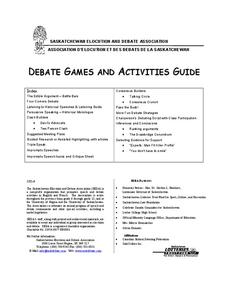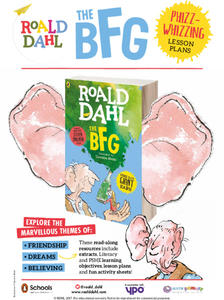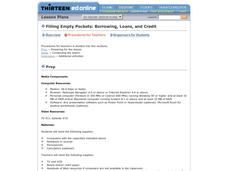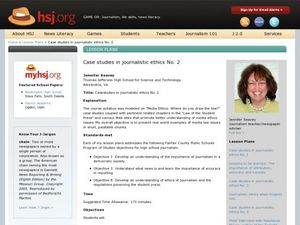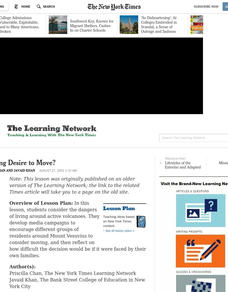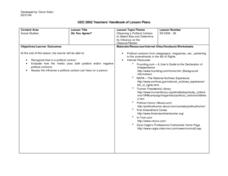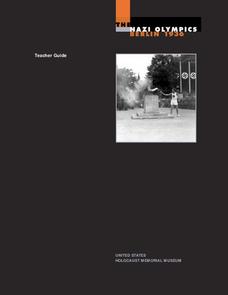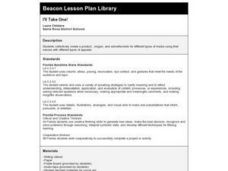Personal Genetics Education Project
Genetics and Reproduction
Disease prevention or designer babies? Use a set of slides to introduce the growing practice of preimplantation genetic diagnosis, or PGD. Teens read related articles and then break into groups to address different scenarios. Afterward,...
Howard Hughes Medical Institute
The Making of the Fittest: The Birth and Death of Genes
Adaptations must be made as environments change. This fabulous presentation features Icelandic icefish, a transparent, scaleless specimen that even has colorless blood. Genetics and adaptations concepts are explored as scientists study...
Saskatchewan Elocution and Debate Association
Debate Games and Activities Guide
A must-have resource for classes that engage in debate, this packet contains 20 detailed plans for debate games and activities. Everything from how to select evidence to support a position, to structuring a debate on which candy bar is...
PBS
Stories of Painkiller Addiction: Learning About Opioids
Feeling high is not the only side effect of abusing prescription opioids. Middle and high schoolers learn more about specific painkillers, including Fentanyl, Oxycodone, and Clonazepam, as well as their common brand names and extensive...
Federal Reserve Bank
The Story of the Federal Reserve System
Prevent the Federal Reserve System from becoming a dry topic for your middle and high schoolers by using an informative, engaging resource! The cartoon takes your class on a journey with aliens from the planet of Novus to observe the...
College Board
2018 AP® Calculus AB Free-Response Questions
Pupils interact with six released questions from the 2018 AP Calculus AB exam. Teachers use the additional materials to determine where the class is in terms of readiness for the exam to help provide additional instruction as needed.
Roald Dahl
The BFG Lesson Plans
A 55-page unit examines the novel, The BFG, by Roald Dahl. Six lessons pay close attention to friendship, dreams, and believing themes while analyzing interesting characters, writing creative vocabulary, smilies, metaphors, an exciting...
Curated OER
FILLING EMPTY POCKETS: BORROWING, LOANS AND CREDIT.
Students learn that maintaining financial security takes a good math understanding. In this lesson, students apply mathematical formulas to make important financial decisions like getting the right loan to buy a house, decide which...
Curated OER
The Art of Violence
Violence and human suffering, as represented in art and film, are the focus of an investigation of the power of visual images and the moral implications of such representations. Class members examine “Guernica,” Pablo Picasso’s massive...
Curated OER
Case Studies in Journalistic Ethics No. 2
Learners use texts on media ethics and various Web sites to explore real world examples of media law issues. For this media ethics lesson, learners examine the Food Lion case using a transcript from the court of appeals session and...
Curated OER
Culture Creation vs. Culture Consumption - Finding Voice Through Digital Storytelling
Ninth graders explore the power of media in culture and Gandhi's philosophy of nonviolence. In this nonviolence and media instructional activity, 9th graders analyze Gandhi's nonviolent methods for social change and discuss the media's...
Curated OER
The Big Mo
Learners develop media literacy and critical thinking skills to analyze trends and determine the extent to which their decisions may be influenced by manipulation. They examine the mathematics of trends and write about a time they...
Museum of Tolerance
Music Evokes Memories and Emotions
Dim the lights, take a deep breath, and press play to explore the emotions and memories that music elicits. Class members begin using relaxation techniques designed to create a positive listening experience. As music plays, learners...
Curated OER
Recognizing a Message's Point of View
Pupils study the physical, mental, and social health benefits of regular exercise while attempting to recognize the point of view of media messages. They read an article and discern ways in which they can make regular exercise a part of...
Curated OER
Hidden Messages: The Growth of Product Placement
Students identify product placements they see in TV programs and movies. They build awareness of the pervasiveness of advertising in their culture. They develop critical skills necessary to think independently in a media saturated...
Curated OER
The Tank Man
Young scholars explore the events surrounding the confrontation at Tiananmen Square between Chinese forces and "The Tank Man." They discover how censorship affects what the media reports and what the public learns. Students research...
Curated OER
A Burning Desire to Move?
Students consider the dangers of living around active volcanoes. They develop media campaigns to encourage different groups of residents around Mount Vesuvius to consider moving.
Curated OER
The Independent Project
Students develop an artistic work ethic, fostering confidence, responsibility and originality. They develop skills and techniques with a variety of media by creating content additional to the regular assignments to go into the final...
Curated OER
Do You Agree?
Students recognize bias in a political cartoon, evaluate how the media uses both positive and/or negative political cartoons, and assess the influence a political cartoon can have on a person.
Curated OER
Being an Educated Consumer of Statistics
Students examine kinds of data used to report statistics, and create their own statistical report based on any of the four sources of media information (Internet, newspaper, TV, magazine).
US Holocaust Museum
Nazi Olympics: Berlin 1936
The Olympics are about more than sports—at times, the games are also a place of racism and prejudice! Pupils investigate the 1936 Olympics in Berlin, Germany. They analyze the meaning behind the materials included in the United States...
Curated OER
I'll Take One!
Fourth graders collectively create a product, slogan, and advertisements for different types of media. They define different types of appeals such as bandwagon, emotional, glittering generalities, snob appeal, plain-folks appeal,...
Curated OER
What is a Dictionary?
Second graders explore the purpose of a dictionary. In this library media activity, 2nd graders explore My First Dictionary and identify guidewords, entry words, and captions. Students list ways they can use the dictionary.
Google
Intermediate 4: Searching for Evidence for Research Tasks
Online resources take many forms: blogs, search engines, news websites, documents, wikis. In order to conduct effective research, pupils should become familiar with different formats so that they can more easily choose suitable sites for...




